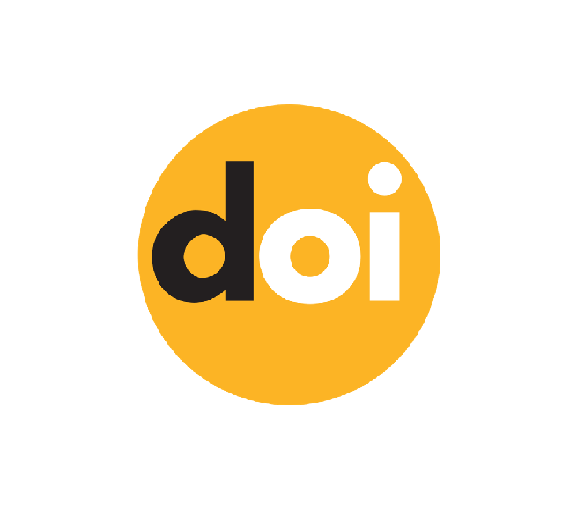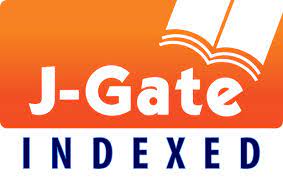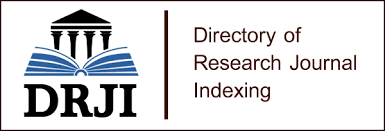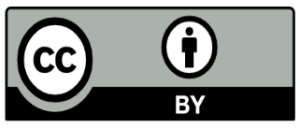AN INDELIBLE LINK BETWEEN LEARNING AND TECHNOLOGY
Abstract
Purpose of this research is to examine the factors of Information and Communication technology (Computer skills, Desktop Presentation Program, Heating Ventilating and Air Conditioning, Assessment Agent System, E-learning, learning from Television, and M-learning) that are associating and impacting the academic achievements of the students.Structured questionnaire was distributed among 357 students to collect the data. For this Correlation and Regression Analysis were applied. The results show that five variables (computer, assessment agent system, e-learning, television, and m-learning) of ICT have a strong association whereas there is no association with desktop presentation program and heating ventilating & air conditioning. Secondly computer, m-learning, and television have direct impact but assessment agent system, e-learning, desktop presentation program, and heating ventilating & air conditioning have no impact.
References
, M, T & Fardous, N. (2016). Students’ Preference of Technology Usage for their Learning Engagement. American Journal of Educational Research, 4, 10: 749-751. doi: 10.12691/education-4-10-7. http://pubs.sciepub.com/education/4/10/7/
Akhtar, S., Warburton, S., & Xu, W. (2015). The use of an online learning and teaching system for monitoring computer aided design student participation and predicting student success. Int J Technol Des Educ. https://link.springer.com/article/10.1007%2Fs10798-015-9346-8
Aladé, F., & Nathanson, A. I. (2016.) What Preschoolers Bring to the Show: The Relation Between Viewer Characteristics and Children’s Learning from Educational Television. Media Psychology, 19, 3: 406-430. https://www.researchgate.net/publication/292071966_What_Preschoolers_Bring_to_the_Show_The_Relation_Between_Viewer_Characteristics_and_Children's_Learning_from_Educational_Television/download
Annan-Coultas, D. L. (2012). Laptops as instructional tools: student perceptions. TechTrends, 56, 5. https://link.springer.com/article/10.1007%2Fs11528-012-0596-y
Baker, L., & Bernstein, H. (2012). The Impact of School Buildings on Student Health and Performance. The Centre for Green Schools. http://www.centerforgreenschools.org/sites/default/files/resource-files/McGrawHill_ImpactOnHealth.pdf
Bello, A. A. (2014). Impact of technology intervention on student achievement in rural nigerian schools. Walden University Scholar works. https://scholarworks.waldenu.edu/cgi/viewcontent.cgi?referer=&httpsredir=1&article=1112&context=dissertations
Bharuthram, S., & Kies, C. (2012). Introducing e-learning in a South Africa higher education institution: Challenges arising from an intervention and possible responses. British Journal of Educational Technology, 44, 3: 410-420. https://www.readcube.com/articles/10.1111%2Fj.1467-8535.2012.01307.x?purchase_referrer=r.search.yahoo.com&tracking_action=preview_click&r3_referer=wol&show_checkout=1
Carnoy, M., Ngware, M., & Oketch, M. (2016). The role of classroom resources and national educational context in student learning gains: Comparing Botswana, Kenya, and South Africa. Chicago Journal, 59, 2: 199-233. https://www.journals.uchicago.edu/doi/full/10.1086/680173
Carrillo, P., Onofa, M., & Ponce, J. (2010). Information Technology and Student Achievement: Evidence from a Randomized Experiment in Ecuador. IDB Working Paper Series No. IDB-WP-223. https://ideas.repec.org/p/idb/wpaper/4698.html
Chen, C.-H., Liu, G.-Z., & Hwang, G.-J. (2015). Interaction between gaming and multistage guiding strategies on students' field trip mobile learning performance and motivation. British Journal of Educational Technology. http://www.etc.edu.cn/public/2018/3/eb96239e-75f3-4314-b911-663035bdffc8.pdf
Conway, P. F., & Amberson, J. (2011). Laptops meet schools, one-one draw: m-learning for secondary 23 students with literacy difficulties. British Journal of Learning Support, 26, 4. https://onlinelibrary.wiley.com/doi/full/10.1111/j.1467-9604.2011.01497.x
de Sousa, L., Richter, B., & Nel, C. (2017). The effect of multimedia use on the teaching and learning of Social Sciences at tertiary level: a case study. Yesterday and Today, 17: 1-22. https://www.researchgate.net/publication/319325707_The_effect_of_multimedia_use_on_the_teaching_and_learning_of_Social_Sciences_at_tertiary_level_a_case_study/download
Fabian, K., Topping, K. J., & Barron, I. G. (2015). Mobile technology and mathematics: effects on students' attitudes, engagement, and achievement. Formative Assessment that truly informs instruction. (2013, october 21). National Council of Teachers of English. https://archive.org/details/ERIC_ED557311
Furio, D., Juan, M. -C., Seguit, I., & Vivo, R. (2014). Mobile Learning vs. traditional classroom lessons: a comparative study. Journal of Computer Assisted Learning, 31: 189-201. https://onlinelibrary.wiley.com/doi/abs/10.1111/jcal.12071
Harley, J. M., Carter, C. K., Papaionnou, N., Bouchet, F., Landis, R. S., Azevedo, R., & Karabachian, L. (2016). Examining the predictive relationship between personality and emotion traits and students’ agent-directed emotions: towards emotionally-adaptive agent-based learning environments. User Modeling and User-Adapted Interaction, 26, 2-3: 177-219. https://link.springer.com/article/10.1007/s11257-016-9169-7
Haverinen-Shaughnessy, U., & Shaughnessy, R. J. (2015). Effects of Classroom Ventilation Rate and Temperature on Students' Test Scores. PLOS ONE. https://journals.plos.org/plosone/article?id=10.1371/journal.pone.0136165
Hegedus, S. J., Tapper, J., & Dalton, S. (2014). Exploring how teacher-related factors relate to student achievement in learning advanced algebra in technology enhanced classrooms. J Math Teacher Educ, 7-32. https://link.springer.com/article/10.1007%2Fs10857-014-9292-5
Jaramillo, A. M. (2013). The Link between HVAC Type and Students Achievement. https://vtechworks.lib.vt.edu/bitstream/handle/10919/50565/Jaramillo_AM_D_2013.pdf
Johnson, T. (2014). The effects of information and communication technology on student achievement. Masters of art in education action research. https://sophia.stkate.edu/cgi/viewcontent.cgi?article=1073&context=maed
Kay, R., & Lauricella, S. (2016). Assessing laptop use in higher education: The Laptop Use Scale. Journal of Computing in Higher Education, 28, 1: 18-44. https://www.researchgate.net/publication/288920347_Assessing_Laptop_Use_in_Higher_Education_The_Laptop_Use_Scale/download
Keung, S, T. (2014). Examining Academic Performance of Polynesian Student-Athletes Using the theory of Planned Behavior. All theses and Dissertations. 4223. http://scholarsarchive.byu.edu/etd/4223. https://scholarsarchive.byu.edu/cgi/viewcontent.cgi?article=5222&context=etd
Khan, G. M. (2012). The impact of television viewing on the academic achievements of students between upper and lower socio-economic level in Karachi. Indus Journal of Management & Social Science, 6, 1: 38-63. https://ideas.repec.org/a/iih/journl/v6y2012i1p38-63.html
Lei, J. (2010). Quantity versus quality: A new approach to examine the relationship between technology use and student outcomes. British Journal of Educational Technology, 41(3), 455- 472. http://marianrosenberg.wiki.westga.edu/file/view/LeiJQuantityVersusQuality.pdf
Liu, J. (2013). The Assessment Agent System: design, development, and evaluation. Education Tech Research Dev. https://link.springer.com/journal/11423
Loughlin, C. (2017). Staff Perceptions of Technology Enhanced Learning in Higher Education. In Proceedings of the 16th European Conference on eLearning, ECEL2017: 335-343. ACPI (Academic Conference Publishing International). http://portal.research.lu.se/ws/files/34114204/ECEL17_Proceedings_p335_343.pdf
lumpkin, R. B., Goodwin Jr, R. T., Hope, W. C., & Lutfi, G. (2014). Code Compliment School Buildings Boost Student Achievement. The Author(s). https://journals.sagepub.com/doi/abs/10.1177/2158244014556993
Macleod, J., & Kefallonitis, E. (2017). Trends Affecting e-Learning Experience Management. In Strategic Innovative Marketing, 753-758. Springer International Publishing. https://link.springer.com/chapter/10.1007/978-3-319-33865-1_93
Malhi, P., Bharti, B., & Sidhu, M. (2015). Use of electronic media and its relationship with academic achievement among school going adolescents. National Academy of psychology (NAOP). https://link.springer.com/article/10.1007/s12646-015-0346-2
Mares, M. L., Sivakumar, G., & Stephenson, L. (2015). From meta to micro: Examining the effectiveness of educational TV. American Behavioral Scientist, 59,14: 1822-1846. https://journals.sagepub.com/doi/abs/10.1177/0002764215596555
Mares, M. L., & Sivakumar, G. (2014). “Vámonos means go, but that’s made up for the showâ€: Reality confusions and learning from educational TV. Developmental psychology, 50, 11: 2498. https://www.researchgate.net/publication/267743468_Vamonos_Means_Go_But_That%27s_Made_Up_for_the_Show_Reality_Confusions_and_Learning_From_Educational_TV#39;s_Made_Up_for_the_Show_Reality_Confusions_and_Learning_From_Educational_TV
Moble, T., Kleimann, M., Rehbein, F., & Pfeiffer, C. (2010). Media use and school achievement - boys at risk? British Journal of Developmental Psychology, 28: 699-725. https://onlinelibrary.wiley.com/doi/full/10.1348/026151009X475307
Mohamad, M., Ismail, I. S., Wahab, N., & Mamat, S. (2016). Medical Students’ Challenges and Strategies in Producing Web TV Programs on YouTube. Creative Education, 7, 04: 604-618. http://file.scirp.org/pdf/CE_2016041516160078.pdf
Prunuske, A. J., Henn, L., Brearley, A. M., & Prunuske, J. (2015). A Randomized crossover design to assess learning impact and student preference for active and passive online learning modules. Med.Sci.Educ. https://link.springer.com/content/pdf/10.1007%2Fs40670-015-0224-5.pdf
Qirim, N. A. (2014). Smart board technology success in tertiary institutions: The case of the UAE University. Educ Inf Technol. https://link.springer.com/article/10.1007/s10639-014-9319-7
Revere, L., & Kovach, J. V. (2011). Online technologies for engaged learning A meaningful synthesis for educators. https://www.researchgate.net/publication/296456436_Online_technologies_for_engaged_learning_A_meaningful_synthesis_for_educators
Rodriguez, A. J. (2010). Exploring the impact of opp (reg) ressive policies on teacher development and on student learning. Cult Stud of Sci Educ: 923-940. https://link.springer.com/article/10.1007%2Fs11422-010-9281-7
Roy, S. D., & Chakraborty, D. K. (2015). Impact of social media/social networks on education and life of undergraduate level students of karimganj town-A survey. International Research Journal of Interdisciplinary & Multidisciplinary Studies (IRJIMS), 1, 1: 141-147. http://oaji.net/articles/2015/1707-1424927502.pdf
Sha, L., Looi, C. -K., Chen, W., & Zhang, B. H. (2011). Understanding mobile learning from the perspective of self-regulated learning. Journal of Computer Assisted Learning, 28: 366-378. https://onlinelibrary.wiley.com/doi/abs/10.1111/j.1365-2729.2011.00461.x
Szu, E., Osborne, J., & Patterson, A. D. (2016). Factual accuracy and the cultural context of science in popular media: Perspectives of media makers, middle school students, and university students on an entertainment television program. Public Understanding of Science. https://searchworks.stanford.edu/view/ns183bq4995
Published
How to Cite
Issue
Section
License
Copyrights for articles published in Journal of Asian and African Social Science and Humanities are retained by the authors, with first publication rights granted to the journal. The journal/publisher is not responsible for subsequent uses of the work. It is the author's responsibility to bring an infringement action if so desired by the author.
Articles published in Journal of Asian and African Social Science and Humanities are published under the Creative Commons Attribution (CC-BY) license, which permits others to distribute, remix, tweak, and build upon your work as long as they credit you for the original creation.
Â














